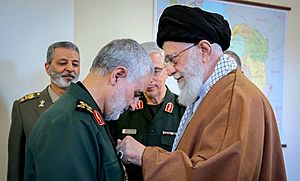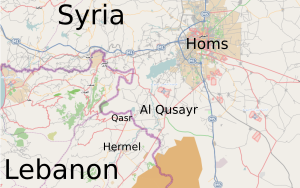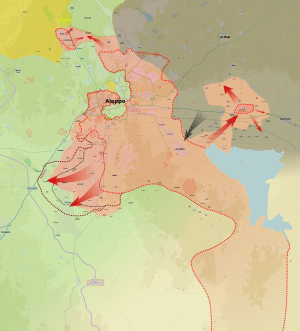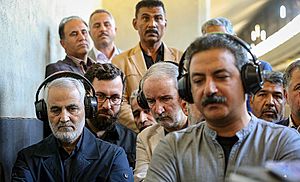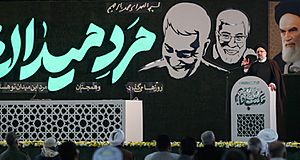Qasem Soleimani facts for kids
Quick facts for kids
Sardar
Qasem Soleimani
|
|
|---|---|
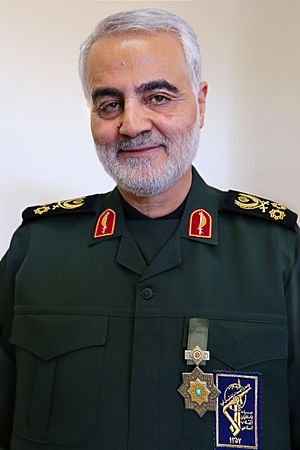
Soleimani in uniform with the Order of Zolfaghar in 2019
|
|
| Native name |
قاسم سلیمانی
|
| Nickname(s) |
|
| Born | 11 March 1957 Qanat-e Malek, Kerman Province, Imperial State of Iran |
| Died | 3 January 2020 (aged 62) Baghdad Airport Road, Baghdad, Iraq |
| Buried | (30°17′31″N 57°07′44″E / 30.291984°N 57.128931°E) |
| Allegiance | |
| Service/ |
|
| Years of service | 1979–2020 |
| Rank | Major General Lieutenant General |
| Commands held |
|
| Battles/wars |
See wars and battles
Kurdish Rebellion (1979) Iran–Iraq War (1980–1988)
KDPI insurgency (1989–96) South Lebanon conflict (1985–2000)
Iran–Israel proxy conflict
2019–20 Persian Gulf crisis
|
| Awards |
|
| Children | 6 |
Qasem Soleimani (born March 11, 1957 – died January 3, 2020) was an Iranian military officer. He served in the Islamic Revolutionary Guard Corps (IRGC), which is a major part of Iran's armed forces. From 1998 until his death in 2020, he led the Quds Force. This special part of the IRGC handles military operations outside of Iran.
Many people saw Soleimani as a very important person in Iran, second only to the country's Supreme Leader, Ali Khamenei. He was also very popular among Iranians.
Soleimani started in construction before joining the IRGC in 1979 during the Iranian Revolution. He quickly became a leader, especially during the Iran–Iraq War. Later, he became the commander of the Quds Force. He played a big role in helping Hezbollah in Lebanon and supporting the Syrian government during the Syrian Civil War. He also helped fight the Islamic State of Iraq and the Levant (ISIL) in Iraq.
Soleimani was killed in a drone strike by the United States on January 3, 2020, in Baghdad, Iraq. This event led to strong reactions and a large funeral in both Iraq and Iran.
Contents
Early Life and Beginnings

Qasem Soleimani was born on March 11, 1957, in a small village called Qanat-e Malek in Kerman Province, Iran. When he was 13, he left school. He moved to the city of Kerman to work in construction. He did this to help his father pay off farming debts.
In 1975, he started working for the Kerman Water Organization. In his free time, he enjoyed weight training and listened to speeches by a preacher named Hojjat Kamyab. These speeches encouraged him to join revolutionary activities.
Military Career Highlights
Soleimani joined the Islamic Revolutionary Guard Corps (IRGC) in 1979, right after the Iranian Revolution. This revolution changed Iran's government. He had very little training but quickly moved up in rank. Early on, he helped stop a Kurdish uprising in northwestern Iran.
When the Iran–Iraq War began in September 1980, Soleimani joined the fight. He led a group of soldiers from his home province of Kerman. He became known for his bravery and for successfully taking back land that Iraq had captured. While still in his 20s, he became the commander of the 41st Tharallah Division. He was involved in most of the major battles on the southern front. He was seriously injured in one battle called Operation Tariq-ol-Qods.
Soleimani also led special missions deep inside Iraq. During this time, he built relationships with Kurdish leaders and Shia groups in Iraq who were against Saddam Hussein.
After the war, in the 1990s, he continued to be an IRGC commander in Kerman Province.
Leading the Quds Force
Soleimani became the commander of the IRGC's Quds Force sometime between 1997 and 1998. The Quds Force is a special unit that handles operations outside of Iran.
After the September 11 attacks in 2001, Iranian diplomats, guided by Soleimani, worked with U.S. forces in Afghanistan. Their goal was to fight the Taliban. This cooperation helped identify targets for air attacks and capture important Al-Qaeda members. However, this teamwork ended in 2002 when U.S. President George W. Bush included Iran in what he called the "Axis of evil".
Soleimani also made the relationship between the Quds Force and Hezbollah stronger. He supported Hezbollah by sending people to help them in southern Lebanon. In 2019, he said he was in Lebanon during the 2006 Israel–Hezbollah War to help manage the conflict.
In 2011, Soleimani was promoted to Major General by Iran's Supreme Leader, Ali Khamenei. Khamenei was said to have a close relationship with Soleimani, even calling him a "living martyr."
Many people saw Soleimani as a very powerful figure in the Middle East. He was considered a key military planner for Iran. He worked to reduce Western influence and increase Iran's influence in the region.
Role in the Syrian Civil War
Soleimani was a strong supporter of the Syrian government and its president, Bashar al-Assad, during the Syrian Civil War. He was involved in planning and carrying out military actions, like the Siege of Baba Amr in 2011.
In late 2012, Soleimani took personal control of Iran's efforts in the Syrian Civil War. He was worried about the Syrian government's ability to fight and what would happen if it fell. He reportedly coordinated the war from a base in Damascus. He worked with Lebanese Hezbollah commanders, Iraqi Shia militia leaders, and Syrian and Iranian officers. Under his command, they planned attacks, trained militias, and monitored rebel communications.
One important event was the retaking of Qusayr in May 2013 from rebel groups. Many believe Soleimani planned this operation. He also helped create the National Defence Forces (NDF) in 2013. This group brought together different pro-Assad forces.
Soleimani was given much credit for the strategy that helped President Assad push back rebel forces and recapture important cities. He helped train government-allied militias and coordinate key military attacks.
Orchestrating Military Efforts in 2015
In 2015, Soleimani worked to gather support to fight the growing Islamic State of Iraq and the Levant (ISIL) and other rebel groups in Syria. These groups had taken control of large areas from Assad's forces. He was reportedly the main planner for a joint effort that included Russia as a new partner with Assad and Hezbollah.
Reports say that in July 2015, Soleimani went to Moscow. He showed Russian officials a map of Syria and explained how the Syrian government could turn its defeats into victories with Russia's help. This visit was the first step in planning Russia's military involvement in Syria. This involvement changed the Syrian war and created a new alliance between Iran and Russia.
Operations in Aleppo
Soleimani had a major impact on military operations in Syria. Under his leadership, government and allied forces made big advances in southern Aleppo. They recaptured military bases and many towns and villages quickly. They also moved towards the Kuweiris air-base in the northeast.
By mid-November 2015, the Syrian army and its allies had gained ground in southern Aleppo. Soleimani was reported to have personally led the push into the southern Aleppo countryside. He reportedly commanded several different military groups, including the Syrian Arab Army's 4th Mechanized Division and various Iraqi and Afghan volunteer groups.
In early 2016, with support from Russian and Syrian air forces, an offensive in northern Aleppo broke a three-year siege of Nubl and Al-Zahraa. This also cut off the rebels' main supply route from Turkey. Iranian fighters played a crucial role in this conflict. In December 2016, photos showed Soleimani at the Citadel of Aleppo.
Fighting ISIL in Iraq
Soleimani played a very important role in Iran's fight against ISIL in Iraq. He was seen as the key person who brought together Kurdish and Shia forces to fight ISIL. He oversaw joint operations between these groups.
In 2014, Soleimani was in the Iraqi city of Amirli. He worked with Iraqi forces to push back ISIL fighters. Amirli was the first town to successfully resist an ISIL invasion. It was secured thanks to a unique partnership of Iraqi and Kurdish soldiers, Shia militias supported by Iran, and U.S. warplanes.
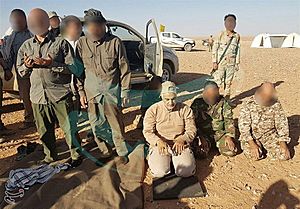
A senior Iraqi official said that when the city of Mosul fell, Iran's quick response, not American bombing, stopped a wider collapse. Soleimani also helped plan the operation to free Amirli. Quds Force members under Soleimani's command were deeply involved with the Iraqi army, Shia militias, and Kurdish forces in the Battle of Amirli. They shared intelligence, provided weapons, and offered their expertise.
During the operation to free Jurf Al Sakhar, Soleimani was reportedly "present on the battlefield." Some Shia militia commanders called him "fearless" because he never wore a flak jacket even on the front lines.
In November 2014, Shia and Kurdish forces led by Soleimani pushed ISIL out of the Iraqi villages of Jalawla and Saadia.
Soleimani was also key in planning the important operation to retake the city of Tikrit from ISIL. Tikrit is a very important city between Baghdad and Mosul. It fell to ISIL in 2014. After its capture, ISIL carried out a terrible massacre at Camp Speicher, killing many Iraqi Army cadets. After months of planning, an offensive to capture Tikrit began in March 2015.
In 2016, photos showed Soleimani at a meeting of Popular Mobilization Forces (PMF) commanders in Iraq. They were discussing the Battle of Fallujah.
Public Image and Legacy
Qasem Soleimani was a very popular figure in Iran. Many conservatives saw him as a hero. By October 2019, polls showed that 82% of Iranians viewed him favorably. He was often seen as the second most powerful person and general in Iran, after Ali Khamenei.
Since the Iran–Iraq War (1980–88), Soleimani became a key planner of Iran's foreign policies in the Middle East. He was a central figure behind Iran's foreign and defense strategies.
After his death, Iranian media and social media accounts increased efforts to portray Soleimani as a heroic figure. They showed him as a "noble warrior," appealing to both nationalists and religious conservatives.
In 2017, a computer animated film called Battle of Persian Gulf II showed Soleimani as the hero. The Resalat Expressway in Tehran was renamed "Shahid Sardar Qasem Soleimani" in his honor.
In August 2020, Iran introduced a new ballistic missile named Martyr Haj Qasem and a new cruise missile named Martyr Abu Mahdi. These were named after Soleimani and Abu Mahdi al-Muhandis, an Iraqi commander killed with him.
The "Shahid Soleimani Plan" is a project to fight COVID-19 in Iran. It involves screening millions of households with the help of "health ambassadors."
Assassination
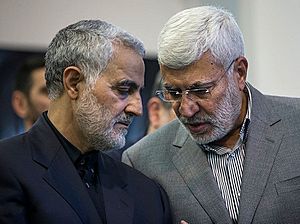
Soleimani was killed on January 3, 2020, around 1:00 a.m. local time, by a U.S. drone strike near Baghdad International Airport. He was on his way to meet Iraqi Prime Minister Adil Abdul-Mahdi. He had just arrived in Iraq from Lebanon or Syria. The Prime Minister said Soleimani was bringing Iran's response to a letter Iraq had sent to Saudi Arabia to ease tensions.
After his death, Soleimani was given the rank of Lieutenant General and praised as a martyr by Iranian officials. Esmail Ghaani took over as the commander of the Quds Force.
The U.S. Defense Department stated the strike was ordered by the President. They said Soleimani had been planning more attacks on American diplomats and military staff. They also said he had approved attacks on the American embassy in Baghdad. The strike was meant to stop future attacks.
Retaliation
On January 7, 2020, Iran's Supreme National Security Council announced it had prepared a plan for revenge. The next day, the Iranian military launched missiles at two U.S. bases in Iraq. No deaths were reported, but over 100 American troops suffered brain injuries. Iranian officials suggested the strike was planned to avoid causing deaths, to prevent a larger American response. Iran's president warned the U.S. that Iran would take more actions if the U.S. continued to interfere in the region.
Anniversary
On January 3, 2021, the first anniversary of Qasem Soleimani's and Abu Mahdi al-Muhandis's deaths was marked in Baghdad. Thousands of Iran-backed militias marched, chanting anti-American slogans.
Commemoration ceremonies were held in Iran and several other countries like Oman, Iraq, Syria, and Portugal. The main ceremony in Iran took place at the University of Tehran.
Awards and Decorations
| Order of Zolfaghar | Order of Fath (1st class) | Order of Fath (2nd class) | Order of Fath (3rd class) |
See also
 In Spanish: Qasem Soleimani para niños
In Spanish: Qasem Soleimani para niños
- List of Iranian two-star generals since 1979
- List of Iranian commanders in the Iran–Iraq War
- List of commanders of the Islamic Revolutionary Guard Corps
- Haj Qasem (missile)
- Mohsen Hojaji



